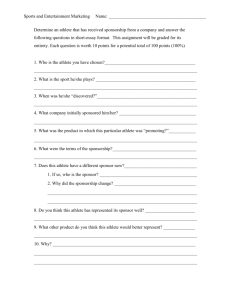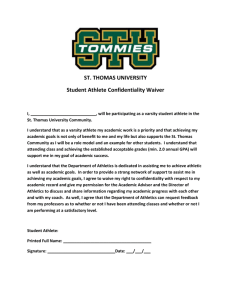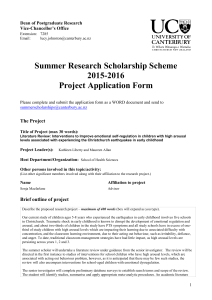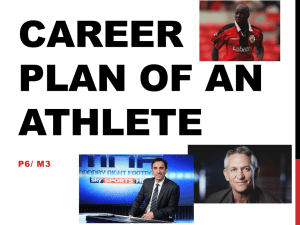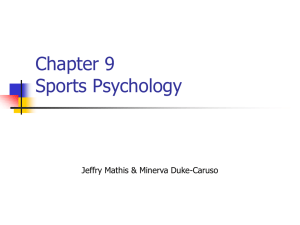Ch. 8 (Exercise Phychology)
advertisement
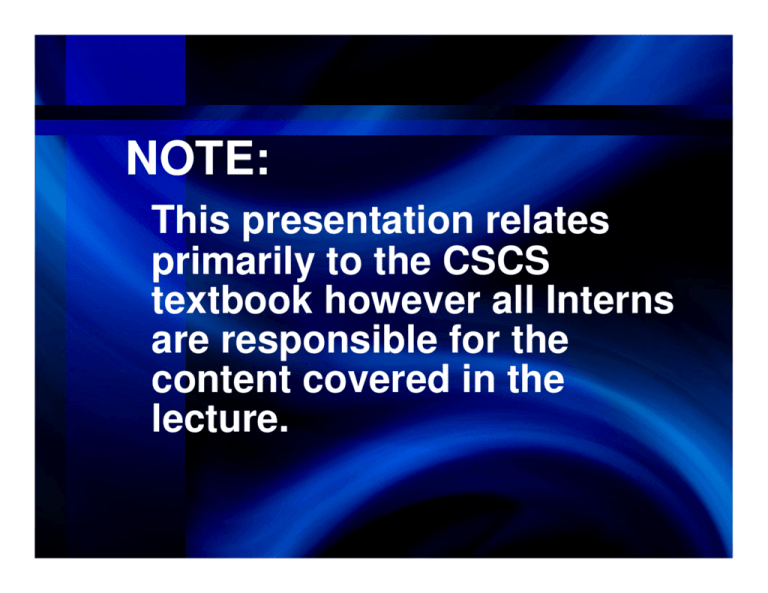
Psychology of Athletic Preparation and Performance NOTE: This presentation relates primarily to the CSCS textbook however all Interns are responsible for the content covered in the lecture. chapter Psychology of Athletic Preparation and Performance 8 Psychology of Athletic Preparation and Performance Bradley D. Hatfield, PhD, FACSM, FAAKPE Evan B. Brody, PhD Chapter Objectives • Understand the relationship between psychological states, physiological arousal, and physical performance. • Comprehend terms relevant to psychological areas of concern, such as arousal, anxiety, attention, the ideal performance state, motivation, and applied sport psychology. • Design a motivational program based on goalsetting principles. • Discuss intervention strategies designed to control psychological and physiological arousal. Section Outline • Definitions of Key Concepts in Sport Psychology – – – – Anxiety: State and Trait Attention and Skill Cue Utilization Attentional Style Definitions of Key Concepts in Sport Psychology • Sport psychology has three major goals: – Measuring psychological phenomena – Investigating the relationships between psychological variables and performance – Applying theoretical knowledge to improve athletic performance Definitions of Key Concepts in Sport Psychology • Anxiety: State and Trait – State anxiety is the actual experience of apprehension and uncontrolled arousal. – Trait anxiety is a personality characteristic, which represents a latent disposition to perceive situations as threatening. Table 8.1 Key Terms • stress: Any disruption from homeostasis or mental and physical calm; can be a negative (distress) or a positive (eustress) state. • stressor: An environmental or cognitive event that precipitates stress. Definitions of Key Concepts in Sport Psychology • Attention and Skill – Attention is defined as the processing of both environmental and internal cues that come to awareness. – The ability to focus attention on task-relevant cues and to control distraction is a skill that can be learned. Key Point • Selective attention is commonly referred to by athletes as their level of focus and refers to the suppression of task-irrelevant stimuli and thoughts. Definitions of Key Concepts in Sport Psychology • Cue Utilization – At low levels of arousal both relevant and irrelevant cues can come to the athlete’s awareness. The athlete may not concentrate well at these underaroused levels. – As arousal increases up to a moderate level, the athlete experiences more focus because of the exclusion of task-irrelevant cues. – At too high levels of arousal, the athlete may not notice task-relevant cues. Cue Utilization • Figure 8.1 (next slide) – Task-relevant cues are represented by a plus sign (+), while task-irrelevant cues are represented by a zero (0). Figure 8.1 Reprinted, by permission, from Research Quarterly for Exercise and Sport, 1980. Definitions of Key Concepts in Sport Psychology • Attentional Style – Internal-external • An introspective versus an externally oriented perspective – Broad-narrow • An integrative (expansive) versus a highly selective orientation Table 8.2 Adapted, by permission, from Nideffer, 1976. Section Outline • How the Mind Affects the Athlete’s Physical Performance How the Mind Affects the Athlete’s Physical Performance • There are direct physical links between the mind and the body. • Tangible physical processes occur in the brain and body as a result of the athlete’s thought processes. • These changes influence neuromuscular activation, coordination, autonomic arousal, and metabolism, which can further cause changes in motor performance. • The resultant changes may be beneficial, detrimental, or neutral, depending on the nature of the task, the athlete’s level of skill, and the complexity of the task in terms of decision making. Section Outline • Ideal Performance State Ideal Performance State • The ideal performance state involves the following: – – – – – – Absence of fear (no fear of failure) No thinking about or analysis of performance A narrow focus of attention on the activity itself A sense of effortlessness A sense of personal control A distortion of time and space Key Point • The ideal performance state is characterized by a “quiet mind” that results in less cortical interference with the (subcortical) motor control centers and in consistent and efficient execution of motor performance. Section Outline • Motivational Phenomena – Intrinsic Motivation – Achievement Motivation – Positive and Negative Reinforcement in Coaching Motivational Phenomena • Intrinsic Motivation – Intrinsic motivation is a desire to be competent and self-determining. – The athlete is a self-starter because of his or her love of the game. Motivational Phenomena • Achievement Motivation – Achievement motivation is the athlete’s wish to engage in competition or social comparison. – Whoever is higher in achievement motivation will be the better athlete because he or she has an appetite for competition. Motivational Phenomena • Positive and Negative Reinforcement in Coaching – Positive reinforcement is the act of increasing the probability of occurrence of a given behavior by following it with or presenting an action, object, or event such as praise, decals on the helmet, or prizes and awards. – Negative reinforcement also increases the probability of occurrence of a given operant by removing an act, object, or event that is typically aversive. Motivational Phenomena • How Should Positive and Negative Reinforcement Be Applied? – Coaches should generally subscribe to a reinforcement strategy to assist athletes in focusing on what they do correctly. – Punishment should be used sparingly because it increases the likelihood that the athlete will focus on what he or she is doing incorrectly. – Positive reinforcement aids focus on task-relevant cues. – Punishment floods attentional capacity with a predominance of task-irrelevant cues. Section Outline • Influence of Arousal on Performance – Inverted-U Theory • • • • Skill Level Task Complexity Personality Trait Anxiety – Optimal Functioning Theory – Catastrophe Theory – Self-Efficacy Influence of Arousal on Performance • Inverted-U Theory – Arousal facilitates performance up to an optimal level, beyond which further increases in arousal are associated with reduced performance. Inverted-U Theory • Figure 8.2 (next slide) – Inverted-U theory and its modifications Figure 8.2 Reprinted, by permission, from Hatfield and Walford, 1987. Influence of Arousal on Performance • Inverted-U Theory – Skill Level • The more skill an athlete has developed, the better he or she can perform during states of less or greater than optimal arousal. – Task Complexity • Simple skills can tolerate a higher degree of arousal (and attentional narrowing). • Skills involving a lot of decision making require low levels of arousal. (continued) Influence of Arousal on Performance • Inverted-U Theory (continued) – Personality • Extroverts are sensory reducers, whereas introverts are sensory augmenters, or increasers. – Trait Anxiety • The athlete with low trait anxiety can handle higher levels of pressure. Influence of Arousal on Performance • Optimal Functioning Theory – Different people perform best with very different levels of arousal. • Catastrophe Theory – When increases in physiological arousal occur in the presence of cognitive anxiety, a sudden drop (rather than a gradual decline) in performance occurs. • Self-Efficacy – Perceived self-confidence about a given task in a specific situation may be a better predictor of task execution than either arousal or anxiety. Section Outline • Mental Management of Physical Resources: Controlling Psychological Processes – Goal Setting • • • • • Process Goals Outcome Goals Short-Term Goals Long-Term Goals Effective Behavioral Coaching (continued) Section Outline (continued) • Mental Management of Physical Resources: Controlling Psychological Processes – Physical Relaxation Techniques • Diaphragmatic Breathing • Progressive Muscular Relaxation • Autogenic Training – Mental Imagery – Hypnosis – Systematic Desensitization Mental Management of Physical Resources • Applied sport psychology involves the employment of techniques to gain control over psychological factors, which influence sport performance. • The validation of such techniques is one mission of the scientific discipline of sport psychology. Mental Management of Physical Resources • Goal Setting – Process Goals • Goals over whose achievement the athlete has control – Outcome Goals • Goals over which the athlete has little control, such as winning – Short-Term Goals • Increase the likelihood of success because they are relatively close to the athlete’s present ability level – Long-Term Goals • Provide relevance to short-term goals Mental Management of Physical Resources • Guidelines for Using Goal Setting – Long-term goals and short-term goals are interdependent. – Long-term goals provide a sense of meaningfulness for pursuing short-term goals. – The attainment of short-term goals provides a hierarchical sense of mastery and success that builds self-confidence. – Athletes should define process goals to focus on elements of their performance over which they have control. Mental Management of Physical Resources • Goal Setting – Effective Behavioral Coaching • A coach specifies the components of a given skill and charts the athlete’s success with each part until the whole skill is mastered. • Feedback, or the knowledge of success and failure, is more effective in the presence of specific, quantifiable goals—as opposed to vague standards of performance. Mental Management of Physical Resources • Goal Setting – Goal setting affects performance because • goals direct an athlete’s attention by prioritizing efforts, • goals increase effort because of the contingency of success on goal attainment, and • goals increase positive reinforcement through the feedback given to athletes. Mental Management of Physical Resources • Physical Relaxation Techniques – Diaphragmatic Breathing • Focusing thought on breathing clears the mind and therefore increases attentional capacity. Mental Management of Physical Resources • Physical Relaxation Techniques – Progressive Muscular Relaxation (PMR) • By going through a series of alternate muscular tensing and relaxing phases, the athlete learns to become aware of somatic tension and thereby to control it. – Autogenic Training • The PMR cycle for each muscle group is replaced with an attentional state that focuses on the sense of warmth and heaviness for a particular limb or muscle group. Key Point • Relaxation techniques are designed to reduce physiological arousal and increase task-relevant focus. These techniques are of extreme importance when one is executing complex tasks and those not well learned. Mental Management of Physical Resources • Mental Imagery – The cognitive psychological skill in which the athlete uses all the senses to create a mental experience of an athletic performance Mental Management of Physical Resources • Hypnosis – An induced state of hypersuggestibility in which positive suggestions relating to an athlete’s performance potential can be planted in the subconscious mind – Can be an effective tool for psychological arousal and sometimes for behavior or performance change • Systematic Desensitization – A hybrid of cognitive and somatic techniques that allows an athlete to replace a fear response to various cues with a relaxation response Mental Management of Physical Resources • How Should Athletes Use Arousal Control Techniques? – An athlete should employ arousal reduction techniques when performing a new skill or one that is complex in nature. – Athletes should employ arousal enhancement techniques when executing simple skills or ones that are well learned. (continued) Mental Management of Physical Resources • How Should Athletes Use Arousal Control Techniques? (continued) – The purpose of employing such techniques is to allow the athlete to perform with an unburdened mind while matching his or her mental and physical intensity to the demands of the task.
